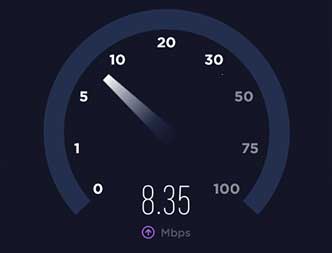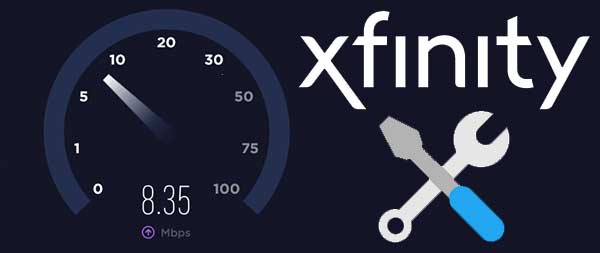If you are one of many Comcast subscribers wondering why your Xfinity upload speeds are so slow and how to fix the problem, you’ve come to the right place.
Many different reasons may cause or contribute to the slow upload speeds, and some of them may just surprise you.
This article will explain how to find out if you have a problem with the upload speeds and what steps you can take if you do.
But, before we go into fixing things, we need to answer the main question about your slow Xfinity upload.

CONTENTS
Is It Broken or Just Slow?
This fact may come as a surprise, but download and upload speeds are largely asymmetrical in most cases, and up until relatively recently, there was a good reason behind this.
Regardless of what type of internet connection you may have, a fixed amount of traffic can pass through the line. That fixed amount of traffic has to be divided between different services like telephone, TV, and the internet. Furthermore, each of those sections needs to be divided between download and upload.
Naturally, engineers did their best to optimize user experience within the limits of existing technology, so they made some compromises that seemed very reasonable at the time.
Back in the nineties, when the internet was still a new thing, most people uploaded very little content to the internet, so download speeds were much more critical than the upload. For most people, the same applies to this day.
Recommended reading:
- How to Fix the Xfinity Cable Box Blinking Green Light?
- How to Turn Off Xfinity Wi-Fi at Night (Explained in Detail)
- Xfinity Router Blinking Blue: How to Fix It?
Led by these facts, even when the new standards and technologies allow much higher download and upload speeds than before, many internet service providers still offer packages with uploads that are up to ten times slower than downloads. Comcast is not an exception to this outdated policy.
Even today, when more and more people are working from home and need that upload speed to attend video conferences or upload large files to the cloud or YouTube, they reserve high upload speeds primarily for their business packages.
So, before you dive into fixing your upload, check your internet plan to find out if there is something that needs fixing or if you are simply getting what you paid for.
Go to some internet speed test page you trust and see your results. You can say you have a problem only if your upload speed is below 80% of what is in your internet plan.
There is nothing to fix if you are in the above 80% bracket. You simply need a different internet plan if you want higher upload speeds, and all you can do is contact Comcast and see if you can work something out.
However, if you are getting less than 80% of what they promised, let’s see what you can do.
Possible Reasons and Solutions for Slow Xfinity Upload Speeds

There are a few possible causes for your slow upload speeds. Let’s list the most common ones and explain how they affect your internet experience.
- Faulty network equipment
- Too many users for your internet plan or infrastructure
- Third-party firewalls
- Company or ISP data caps
1. Faulty Network Equipment
It can be your network card, router, or modem on your end or some of the equipment Comcast uses to transfer the internet to and from your home. In any of those cases, you may experience upload speeds significantly lower than promised by the ISP.
To pinpoint and eliminate the equipment as a possible cause of the problem, restart both the modem and the router if you have them as separate units or the Gateway, a combo unit. Also, make sure that the firmware is up-to-date.
If not, perform the update manually from the settings. Measure upload speeds before and after to see if there is any difference.
If everything stays pretty much the same as before, your problem probably has a different origin.
2. Too Many Users for Your Internet Plan or Infrastructure
This can also be a significant contributing factor. It can be caused by having too many demanding users on your network or if Comcast has too many users for the infrastructure they are currently using in your area. You can easily find out if this is the case.
Firstly, disconnect all devices from your network but one, then use that device to perform a speed test. Suppose you see a significant increase in speed, matching Comcast’s promise. You should consider reducing the number of connected devices or reserving upload for the device that needs it the most.
You can find out if Comcast’s infrastructure is the cause of the problem by performing speed tests at different times of the day. If there are too many users on the existing infrastructure, your speeds will drop significantly when most people are at home and online.
3. Third-Party Firewalls
Some people think you can never be too careful, but to be honest – you can. If you don’t know what you are doing and install third-party antivirus software with a built-in firewall, you might end up giving a lot of internet speed for very little or no gain at all.
Firstly, there is a firewall built into your router, and then there is one that comes with the operating system. And those firewalls work pretty well. Suppose you decide to put another firewall on top of those.
In that case, it will only slow down the entire system because there will be another piece of software checking all the data packages coming in and from your PC for, pretty much, no justifiable reason.
The bottom line is to remove any additional third-party firewalls and test your internet speeds. You might end up very surprised by the result.
4. Company or ISP Data Caps

Depending on the location and connection type, your internet upload speed can be throttled by your company if you use the internet in the office or the internet service provider.
Xfinity is known to reduce Internet speeds to users if they notice you are using your entire bandwidth for an extended time, especially if the user is connected via coaxial cable and located somewhere where many other users have to share the same infrastructure. City blocks and large apartment buildings are good examples of such locations.
If you suspect that your company or ISP is throttling down your upload, you need to talk with the support and resolve the issue.
Summary
Before you start panicking and chasing ghosts, find your internet plan and see what it says. Comcast is notorious for having very low upload speeds compared to download and many other ISPs. They usually reserve internet plans with decent upload speeds for business users and the best packages.
Once you find out what your upload speed should be, go to a website like www.speedtest.net and test it. You have a reason to act if you are getting less than 80% of what Xfinity promised.
Firstly, check and restart your network equipment, then make sure you don’t have too many users on your network. Thirdly, uninstall all third-party firewalls if you have them installed, and lastly, contact Xfinity to see if they have put a data cap on your internet plan.

Hey, I’m Jeremy Clifford. I hold a bachelor’s degree in information systems, and I’m a certified network specialist. I worked for several internet providers in LA, San Francisco, Sacramento, and Seattle over the past 21 years.
I worked as a customer service operator, field technician, network engineer, and network specialist. During my career in networking, I’ve come across numerous modems, gateways, routers, and other networking hardware. I’ve installed network equipment, fixed it, designed and administrated networks, etc.
Networking is my passion, and I’m eager to share everything I know with you. On this website, you can read my modem and router reviews, as well as various how-to guides designed to help you solve your network problems. I want to liberate you from the fear that most users feel when they have to deal with modem and router settings.
My favorite free-time activities are gaming, movie-watching, and cooking. I also enjoy fishing, although I’m not good at it. What I’m good at is annoying David when we are fishing together. Apparently, you’re not supposed to talk or laugh while fishing – it scares the fishes.
